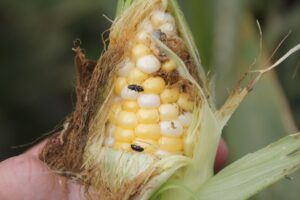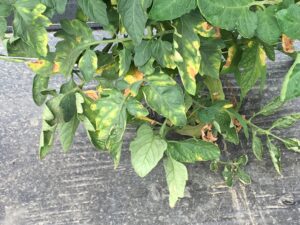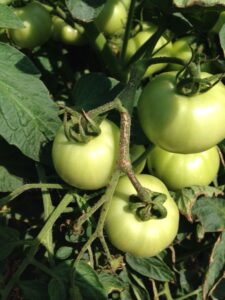Sweet Corn
Low numbers of European corn borer (ECB) moths remain a sporadic, low component of blacklight trap catches. Feeding in whorl and pre-tassel stage is now less common, as control has been applied to infested plantings and later blocks (now in whorl stage) have avoided most of the egg laying period. Slightly higher adult activity is in scattered pockets around the state (see map below at right). ECB injury over the threshold of 12% of plants infested, while still around, has generally been declining over this past week. We expect feeding wind down over the next week or so as we move into the period between generations.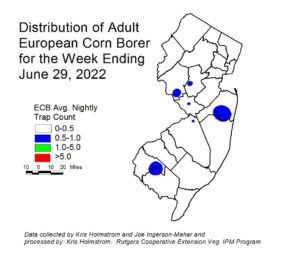
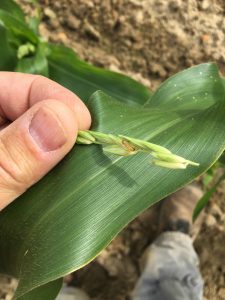 Look for the characteristic “shot-hole” type of feeding (photo below at right) and consider treating when infested plants exceed 12% in a 50 plant sample. As plantings proceed to the pre-tassel stage, ECB larvae may be found in emerging tassels (see photo at left). It is a good idea to treat individual plantings as they move into the full tassel/first silk stage one time. This eliminates any ECB larvae that have emerged with the tassels as they begin to move down the stalk to re-enter near developing ears.
Look for the characteristic “shot-hole” type of feeding (photo below at right) and consider treating when infested plants exceed 12% in a 50 plant sample. As plantings proceed to the pre-tassel stage, ECB larvae may be found in emerging tassels (see photo at left). It is a good idea to treat individual plantings as they move into the full tassel/first silk stage one time. This eliminates any ECB larvae that have emerged with the tassels as they begin to move down the stalk to re-enter near developing ears.
Useful insecticides for this particular application include synthetic 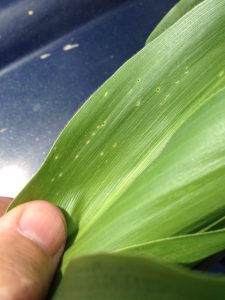 pyrethroids (IRAC Grp 3), spinosyns (including OMRI approved Entrust) IRAC Grp 5), and diamides such as Coragen or Vantacor (IRAC Grp 28) or materials such as Besiege which include the active ingredient in Coragen. Synthetic pyrethroids alone should NOT be used for corn earworm (CEW) protection on silking corn. Control with these materials is very inconsistent.
pyrethroids (IRAC Grp 3), spinosyns (including OMRI approved Entrust) IRAC Grp 5), and diamides such as Coragen or Vantacor (IRAC Grp 28) or materials such as Besiege which include the active ingredient in Coragen. Synthetic pyrethroids alone should NOT be used for corn earworm (CEW) protection on silking corn. Control with these materials is very inconsistent.
The highest nightly trap catches of ECB for the week ending 6/29/22 are as follows:
| Bellemeade 1 | Farmingdale 1 | Morristown 1 |
| Blairstown 1 | Georgetown 1 | New Egypt 1 |
| Centerton 1 | Lawrenceville 1 | Princeton 1 |
| Crosswicks 1 | Matawan 1 | Sergeantsville 1 |
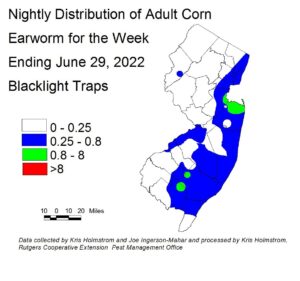 Corn earworm (CEW) moths captures from blacklight traps have remained steady at low levels around the state. We will use a combination of pheromone and blacklight trap types to derive silk spray schedules by region. This week, pheromone trap captures have declined substantially. The number of pheromone traps deployed is much lower, resulting in much broader color bands on the map. It is also important to understand that pheromone traps are more sensitive than blacklight traps, and thresholds are adjusted to account for the higher catches typical of this trap type. Silking corn is at risk of CEW infestation at this time. On the blacklight map (left), green areas represent a 3-4 day silk spray schedule and blue represents a 4-5 day schedule. On the pheromone map (below), green represents a 4-5 day schedule. Blue and white areas on the pheromone map correspond to a 5-6 day spray schedule. Be sure to access information from this publication in the upcoming weeks to determine how frequently you should treat silking sweet corn to protect it from CEW infestation.
Corn earworm (CEW) moths captures from blacklight traps have remained steady at low levels around the state. We will use a combination of pheromone and blacklight trap types to derive silk spray schedules by region. This week, pheromone trap captures have declined substantially. The number of pheromone traps deployed is much lower, resulting in much broader color bands on the map. It is also important to understand that pheromone traps are more sensitive than blacklight traps, and thresholds are adjusted to account for the higher catches typical of this trap type. Silking corn is at risk of CEW infestation at this time. On the blacklight map (left), green areas represent a 3-4 day silk spray schedule and blue represents a 4-5 day schedule. On the pheromone map (below), green represents a 4-5 day schedule. Blue and white areas on the pheromone map correspond to a 5-6 day spray schedule. Be sure to access information from this publication in the upcoming weeks to determine how frequently you should treat silking sweet corn to protect it from CEW infestation.
The highest nightly blacklight trap catches of CEW for the week ending 6/29/22 are as follows:
| Matawan 3 | East Vineland 1 | Morristown 1 |
| Allentown 1 | Farmingdale 1 | Sergeantsville 1 |
| Cinnaminson 1 | Georgetown 1 | Springdale 1 |
| Crosswicks 1 | Milltown 1 | Tabernacle 1 |
The highest nightly pheromone trap catches of CEW for the week ending 6/29/22 are as follows: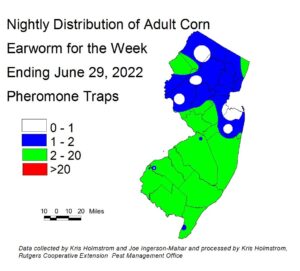
| Berlin 20 | East Vineland 6 | Georgetown 2 |
| Monroeville 19 | Elm 5 | Green Creek 2 |
| Tabernacle 15 | Allamuchy 4 | Oldwick 2 |
| Woodstown 13 | Dayton 3 | Pedricktown 2 |
Silking Spray Schedules*:
South – 4 days
Central – 4-5 days
North – 5-6 days
*These recommendations are based on regional catches. Adhere to tighter spray schedules if indicated by local trap catches. Synthetic pyrethroids alone should NOT be used for corn earworm (CEW) protection on silking corn, or for fall armyworm (FAW) management at any stage. Control with these materials is very inconsistent.
Fall armyworm (FAW) infestations have been discovered in whorl stage sweet corn in Cape May County. While individual larvae have been found northward to Monmouth County in recent weeks, the Cape May infestation is the first one of significance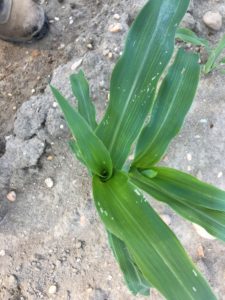
 . This occurrence is earlier than we typically see FAW infestations, and while it may be a transient event, growers should be on the lookout for this pest. FAW feeding can result in significant injury to whorl and even seedling stage corn. Injury from newly hatched larvae shows up as “window panes” or areas where leaf tissue has been eaten down the the lower epidermis (see photo at left). This injury leads down into the whorl. As larvae gain size, they begin to consume leaf tissue in its’ entirety, creating ragged holes and lots of droppings (see photo at right). FAW can be tough to manage because it is resistant to synthetic pyrethroid insecticides (IRAC 3A) and because larvae are often covered by their own droppings, making contact with the insecticide more difficult. Treat when 12% or more plants exhibit FAW injury alone, or in combination with ECB injury. As a rule, insecticides that are most effective on CEW will also adequately control FAW.
. This occurrence is earlier than we typically see FAW infestations, and while it may be a transient event, growers should be on the lookout for this pest. FAW feeding can result in significant injury to whorl and even seedling stage corn. Injury from newly hatched larvae shows up as “window panes” or areas where leaf tissue has been eaten down the the lower epidermis (see photo at left). This injury leads down into the whorl. As larvae gain size, they begin to consume leaf tissue in its’ entirety, creating ragged holes and lots of droppings (see photo at right). FAW can be tough to manage because it is resistant to synthetic pyrethroid insecticides (IRAC 3A) and because larvae are often covered by their own droppings, making contact with the insecticide more difficult. Treat when 12% or more plants exhibit FAW injury alone, or in combination with ECB injury. As a rule, insecticides that are most effective on CEW will also adequately control FAW.
Extremely hot days, very warm night temperatures and longer silk spray (5-6 day) intervals can result in significant sap beetle infestations. These pests (photo at right) invade ears following insect or bird damage, but also when sustained high temperatures cause ears to exceed good husk cover. Super sweet varieties seem especially prone to this under hot conditions. While we haven’t had extremely warm night temperatures yet, hot weather is forecast for later this week. Materials used for CEW control, that will also manage sap beetles include synthetic pyrethroids (IRAC 3A (in combination with diamides IRAC 28)), methomyl (Lannate IRAC 1A), and acetamiprid (Assail, Anarchy IRAC 4A – must be combined with another recommended CEW material for CEW control). If husk cover is poor, and sap beetles are detected, it may be necessary to shorten the suggested silk spray interval by a day, using effective materials for both CEW and sap beetle while conditions affecting tip cover last.
Tomatoes
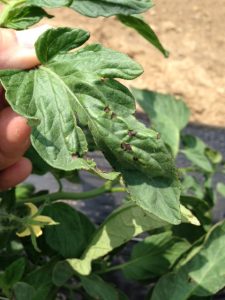 Bacterial leaf spot (BLS) symptoms are now more common in NJ tomato fields. Symptoms of this infection include small, very dark lesions appearing on foliage of any age (see photo at left). Often even immature, unexpanded leaves are affected. Copper resistance in BLS populations in NJ has been identified. Additionally, one incidence (so far) of bacterial canker has been detected in scouted plantings in central NJ. This disease is first characterized by marginal lesions on older foliage (photo below at left). These lesions work inward, ultimately killing entire leaves. Fruit lesions, also called bird’s eye spot (photo below at center) are initiated on very small fruit but become apparent as fruit enlarge. Dry lesions also may form on petioles (photo below at right). It is advisable that growers avoid working in fields when foliage is wet, to avoid easy spread of infections. Growers should also work from youngest blocks to oldest, to limit the chance of spreading disease to younger plants. Pruning, tying and harvesting are all ways that these diseases are dispersed throughout plantings. Bacterial infections in the field may be mitigated to some degree with systemic immune response activator Actigard, although results are often limited if weather and human activity favor spread. See the Tomato Section of the 2022/23 Commercial Vegetable Production Recommendations for further information.
Bacterial leaf spot (BLS) symptoms are now more common in NJ tomato fields. Symptoms of this infection include small, very dark lesions appearing on foliage of any age (see photo at left). Often even immature, unexpanded leaves are affected. Copper resistance in BLS populations in NJ has been identified. Additionally, one incidence (so far) of bacterial canker has been detected in scouted plantings in central NJ. This disease is first characterized by marginal lesions on older foliage (photo below at left). These lesions work inward, ultimately killing entire leaves. Fruit lesions, also called bird’s eye spot (photo below at center) are initiated on very small fruit but become apparent as fruit enlarge. Dry lesions also may form on petioles (photo below at right). It is advisable that growers avoid working in fields when foliage is wet, to avoid easy spread of infections. Growers should also work from youngest blocks to oldest, to limit the chance of spreading disease to younger plants. Pruning, tying and harvesting are all ways that these diseases are dispersed throughout plantings. Bacterial infections in the field may be mitigated to some degree with systemic immune response activator Actigard, although results are often limited if weather and human activity favor spread. See the Tomato Section of the 2022/23 Commercial Vegetable Production Recommendations for further information.
Pepper weevil – Pheromone traps have been set out across southern New Jersey. As yet, no weevils have been trapped and no fields are known to be infested. A fact sheet is now available for anyone interested in monitoring for pepper weevils on their own: FS1330: Monitoring and Management of Pepper Weevil in New Jersey (Rutgers NJAES).
Potato Leafhopper
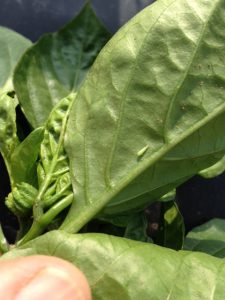 Potato leafhopper (PLH) adults (see photo at left) continue to be found in snap beans and other crops over the past week. This pest is a particular problem because it often goes unnoticed until foliar distortion and burn occurs. Once this damage appears in beans and some potato varieties, yields have already been compromised. It is critical that beans be monitored regularly for the presence of PLH. If a sweep net is available, consider treating if more than 100 nymphs and adults are present in 20 sweeps of pre-bloom stage plants. This threshold increases to 250 during bloom and to 500 per 20 sweeps during pod development. If no sweep net is available, check plants in 10 random field locations and consider treating if adults and nymphs are found throughout. Adults are pale green, and will fly out from foliage when disturbed and immediately fly back into the plant canopy. Nymphs are wingless and bright green and may be found on the underside of leaves.
Potato leafhopper (PLH) adults (see photo at left) continue to be found in snap beans and other crops over the past week. This pest is a particular problem because it often goes unnoticed until foliar distortion and burn occurs. Once this damage appears in beans and some potato varieties, yields have already been compromised. It is critical that beans be monitored regularly for the presence of PLH. If a sweep net is available, consider treating if more than 100 nymphs and adults are present in 20 sweeps of pre-bloom stage plants. This threshold increases to 250 during bloom and to 500 per 20 sweeps during pod development. If no sweep net is available, check plants in 10 random field locations and consider treating if adults and nymphs are found throughout. Adults are pale green, and will fly out from foliage when disturbed and immediately fly back into the plant canopy. Nymphs are wingless and bright green and may be found on the underside of leaves.
Cucurbit Downy Mildew
Cucurbit downy mildew has been detected on cucumbers in southern New Jersey (see Dr. Wyenandt’s cucurbit downy mildew alert of 6/11/22), and in Lancaster County, PA. All cucumber plantings should be protected at this time. Useful materials for CDM may be found in the Cucumber Section of the 2022/23 Commercial Vegetable Production Recommendations. A sentinel plot is now established at Snyder Farm in Hunterdon County. This plot, consisting of pumpkin, watermelon, cantaloupe, butternut, acorn, cucumber and kabocha squash will be used to indicate the presence of cucurbit downy mildew in the region, and what crops are affected. For regional information on this important disease, see the Cucurbit Downy Mildew Forecast webpage: http://cdm.ipmpipe.org/. ‘This past Monday’s rainy weather created good conditions for CDM spread, but as of Wednesday June 29, the forecast was for minimal risk of new infection in NJ. Again, the current local infection is impacting cucumber only.
Pumpkins and Winter Squash
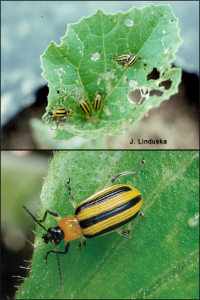 As seedlings emerge, it is critical that they be protected from striped cucumber beetles. These beetles (see photos at left) are attracted to plant chemicals found in leaves, and particularly in the seed leaves. As they feed, they can transmit bacterial wilt to the plants. Heavy feeding can dry out young plants as well. Many commercial varieties come with a seed treatment that includes a neonicotinoid (IRAC 4A) insecticide. This protects the seedlings in the critical 0-4 true leaf stage. Seeds for organic production and some more obscure gourd seeds are not treated and are at risk immediately upon emergence. Rotation away from cucurbit fields helps to limit population buildup locally. Destroy crops immediately upon the end of their useful life. Row covers may be useful in protecting the 0-4 true leaf stage plants in organic production. Scout fields weekly, checking 5 consecutive plants each in 10 random locations. Consider treating for cucumber beetles if they are found actively feeding in 5 or more of the 10 sites. It is unlikely that this threshold will be met if treated seed was planted. After plants begin to run, cucumber beetle feeding is much less important because the plants have developed enough mass to limit the impact of any bacterial infection. Cucumber beetles become a significant pest again later in the season, when they can return to feed on the rinds of developing fruit. Insecticides useful for control of this pest include synthetic pyrethroids (IRAC 3A), diamides (IRAC 28) and neonicotinoids (IRAC 4A), and are found in the Pumpkin and Winter Squash Section of the 2022/23 Commercial Vegetable Recommendations. It is critical to avoid bee exposure with most insecticidal sprays. Evening applications will avoid most bees as they do not forage at that time.
As seedlings emerge, it is critical that they be protected from striped cucumber beetles. These beetles (see photos at left) are attracted to plant chemicals found in leaves, and particularly in the seed leaves. As they feed, they can transmit bacterial wilt to the plants. Heavy feeding can dry out young plants as well. Many commercial varieties come with a seed treatment that includes a neonicotinoid (IRAC 4A) insecticide. This protects the seedlings in the critical 0-4 true leaf stage. Seeds for organic production and some more obscure gourd seeds are not treated and are at risk immediately upon emergence. Rotation away from cucurbit fields helps to limit population buildup locally. Destroy crops immediately upon the end of their useful life. Row covers may be useful in protecting the 0-4 true leaf stage plants in organic production. Scout fields weekly, checking 5 consecutive plants each in 10 random locations. Consider treating for cucumber beetles if they are found actively feeding in 5 or more of the 10 sites. It is unlikely that this threshold will be met if treated seed was planted. After plants begin to run, cucumber beetle feeding is much less important because the plants have developed enough mass to limit the impact of any bacterial infection. Cucumber beetles become a significant pest again later in the season, when they can return to feed on the rinds of developing fruit. Insecticides useful for control of this pest include synthetic pyrethroids (IRAC 3A), diamides (IRAC 28) and neonicotinoids (IRAC 4A), and are found in the Pumpkin and Winter Squash Section of the 2022/23 Commercial Vegetable Recommendations. It is critical to avoid bee exposure with most insecticidal sprays. Evening applications will avoid most bees as they do not forage at that time.
